There are a few things in life that are certain… death, taxes and a new ONTAP release every 6 months!
ONTAP 9.5 was just officially announced at Insight 2018, and this blog will give you the technical breakdown of all the new goodness. We’ll have a new podcast up soon to cover it as well.
If you want to download and install it, you can find it here:
https://mysupport.netapp.com/products/ontap9/9.5RC1/index.html
Also, check out the following podcast episodes for more information:
- Behind the Scenes: Episode 165 – Accelerate your NAS Data with FlexCache
- Behind the Scenes: Episode 164 – NEW with ONTAP 9.5 : NetApp Data Availability Services for the Hybrid Cloud
- Behind the Scenes: Episode 163 – ONTAP 9.5
I also created a shorter, more digestible feature recap here:
If you’re going to be at Insight (Las Vegas or Barcelona), or if you want to review sessions after the event, you can check out the following session:
1214-2 – What’s On Tap in the Next Major Release of NetApp ONTAP
What’s new?
Generally speaking, new stuff in ONTAP comes in the following forms:
- New features
- Enhanced features
- Bug fixes
With the 6 month cadence, features are often phased in, with new features being released with stability as the top priority. Feature parity comes in chunks in later releases. Bug fixes are a part of every ONTAP release.
So, let’s start with…
New Features
ONTAP 9.5 continues the emphasis on the “modern datacenter” with a slew of new features that help enable higher performance and better resiliency, as well as extending your storage stack beyond on-premises and into a true global architecture.
SnapMirror Synchronous
SnapMirror Synchronous adds the ability to replicate – at a volume level – data cross a WAN connection (RTT <10ms – distance of ~150km) with zero Recovery Point Objective (RPO) and near-zero Recovery Time Objective (RTO). This helps address regulatory and industry mandated needs for synchronous replication.
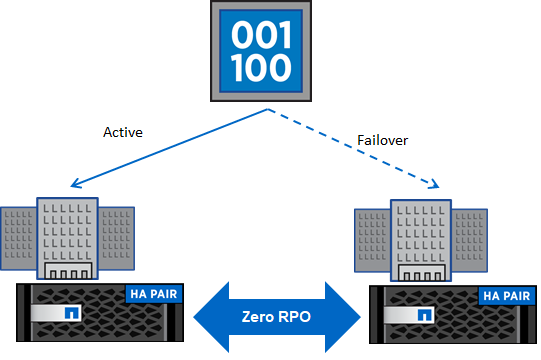
SnapMirror Synchronous will have two different modes available in the initial release.
Full Synchronous
This is the default mode and guarantees zero application data loss between sites by disallowing writes if the SnapMirror Synchronous replication fails for any reason. This provides the “zero RPO” guarantee.
Relaxed Synchronous
Alternatively, relaxed mode allows application writes to continue to a primary site if the SnapMirror Synchronous relationship fails. Once the relationship is able to resume, resync will automatically occur.
In the initial release of SnapMirror Synchronous, NFSv3, iSCSI and FCP will be supported. Licensing will be capacity-based, in addition to the base SnapMirror license.
FlexCache Volumes
One thing I’ve heard fairly often is “how can I serve NAS data across multiple sites while still honoring locking mechanisms?” Previously, the only way to accomplish this was by way of a 3rd party NAS lock orchestrator. Now, in ONTAP 9.5, NAS data can be shared across multiple global sites with performance as if the NAS data was local with FlexCache volumes and provides a true global namespace for ONTAP.
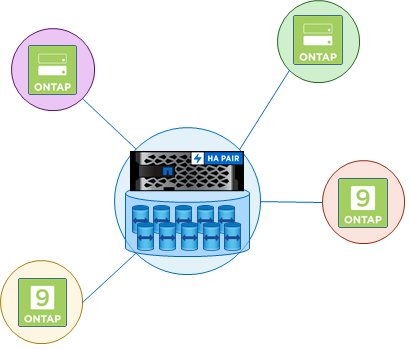
FlexCache volumes are sparsely populated volumes that can be cached on the same cluster or a different cluster as the origin volumes to accelerate data access. FlexCache volumes are created on FlexGroup volumes and can cache reads, writes and metadata. Writes are currently using write-around for locking orchestration at the origin. FlexCache volumes can also help offload mount points to avoid hot spots. Initially, NFSv3 will be the only supported protocol, but future releases will enable more data protocol support.
BGP routing support
The networking stack in ONTAP is getting a bit of a makeover in ONTAP 9.5 as well. Previously, data LIFs in ONTAP were hosted on a single physical port, which lived on a single physical node. Load balancing was done via layer 2 (L2) hashing, which wasn’t super efficient, as hash collisions would leave ports underutilized or even completely unused! When storage nodes have 40GB and 100GB ports, that can be an expensive waste of resources. Additionally, the L2 architecture meant that additional layer 3 (l3) switches needed to be in place to provide proper network traffic distribution.
ONTAP 9.5 introduces support for L3 routing via the Border Gateway Protocol (BGP), which allows ONTAP to automatically load balance traffic based on routing metrics, rather than L2 hashes. Additionally, this allows data LIFs to become Virtual IPs (VIPs) that can live anywhere in the network, which adds better redundancy for IP failover events, and avoids inactive links. This also eliminates the need for L3 switching infrastructure, which reduces overall CapEx and OpEx networking costs.
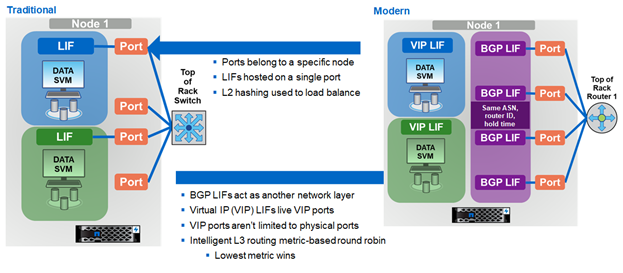
ONTAP 9.5 is further modernizing the datacenter by modernizing its networking stack.
Logical Space Accounting
ONTAP 9.4 introduced a way to report storage efficiency savings to storage administrators, but to mask those savings to users. For example, if a user is writing to a 10TB volume and 6TB of data has been written to the volume, but storage efficiencies have saved 2TB, then ONTAP can report the actual 6TB of capacity back to users, rather than the 4TB used by way of space savings. This provides storage administrators a way to charge back properly to end users and helps prevent overruns of storage capacity.
ONTAP 9.5 ups the game by integrating logical space accounting into quota enforcement, which not only displays the logical space used, but also prevents new writes once a quota has been reached based on the logical space used.
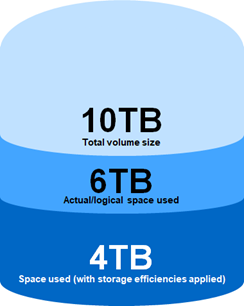
MAX Data
While this was announced a couple months ago, MAX Data officially makes its debut alongside ONTAP 9.5. This is a server-side software product that lives outside of ONTAP. We covered it on the Tech ONTAP Podcast in Episode 154.
MAX Data offers ultra-low latency (think sub 10 microsecond) and more Ops/second with server-side software-based memory acceleration that leverages persistent memory such as NVDIMM and Optane Memory as they become available. Based on the Plexistor technology that NetApp acquired last year, MAX Data also offers enterprise-class data resiliency with MAX Recovery technology, for high availability and faster data recovery.
MAX Data can help accelerate database applications like Oracle, Cassandra, MongoDB and a variety of other Linux-based applications.
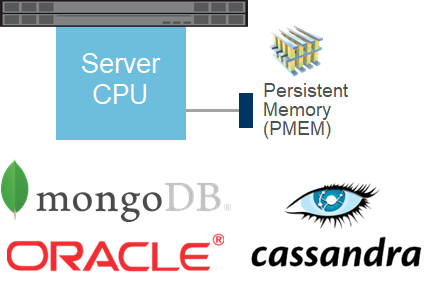
NetApp Data Availability Services (NDAS)
While not technically an ONTAP feature (though there are ONTAP elements such as the NDAS proxy and copy-to-cloud APIs), NetApp Data Availability Services is an integral part of the NetApp Data Fabric. It’s a cloud-resident orchestration app that simplifies hybrid cloud data protection workflows behind a single pane of glass. It’s also an intuitive search catalog for easy file and volume restores and leverages intelligent S3 object storage in AWS for lower cost solutions for backing up your ONTAP data. For more information, see https://www.netapp.com/ndas.
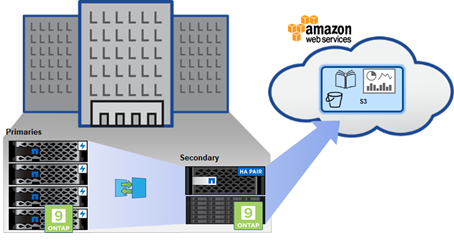
Feature Enhancements
NVMe over FC – Industry’s only HA failover story for NVMeoFC namespaces via asymmetric namespace access (ANA), which is a NVMe standard that NetApp helped develop.
Storage efficiencies – Up to 15% more storage efficiencies seen with compression improvements.
FlexGroup volumes – New functionality such as FabricPool support, quota enforcement and qtree statistics open up a whole new set of workloads that can leverage FlexGroup volumes, such as home directories.
SnapLock – SnapLock adds feature enhancements such as Unified SnapMirror engine support, resync without data loss, clock synchronization in software defined ONTAP and 1,023 snapshot support.
MetroCluster (MCC) – ONTAP 9.5 adds support for SVM-DR and ONTAP Select with MetroCluster, increases the supported distance for MCC IP to 700km(!), and expands the platforms supported for use with MCC IP to the A300 and FAS8200 series.
Great overview! Thanks
LikeLike
I’m excited about BGP! Does this mean the traffic would be routed to the node with the data?
Also looks like we’d need a “top of rack” router or something with similar functionality to make it work.
Though one of my colleagues is adamant that BGP is only for ISP’s, and we’d only us it if we were exposing the controllers to the Internet.
LikeLike
Lots of great improvements to an already solid storage OS! Can’t wait to try this in our lab !
LikeLike
Reblogged this on Why Is The Internet Broken? and commented:
ONTAP 9.5RC1 is Available! Check it out here!
LikeLike
When is QTree snapmirror coming back?
LikeLike
I don’t know that there are any plans for qtree snapmirror, but I do believe there are other things coming down the pipe that may be able to solve similar problems. 🙂
LikeLike